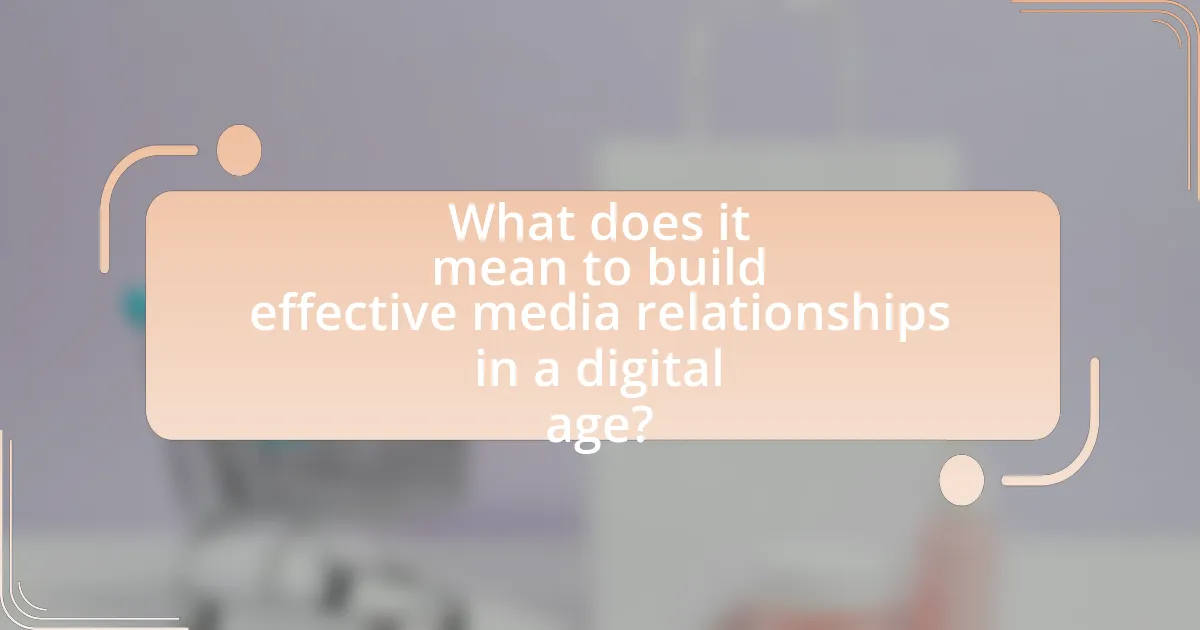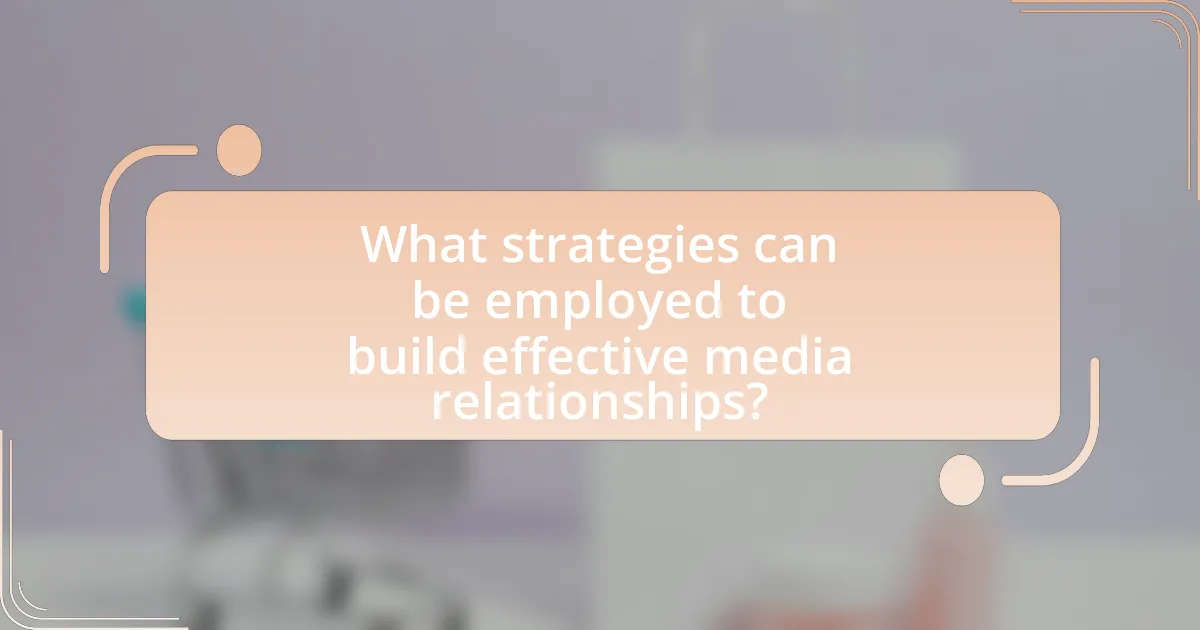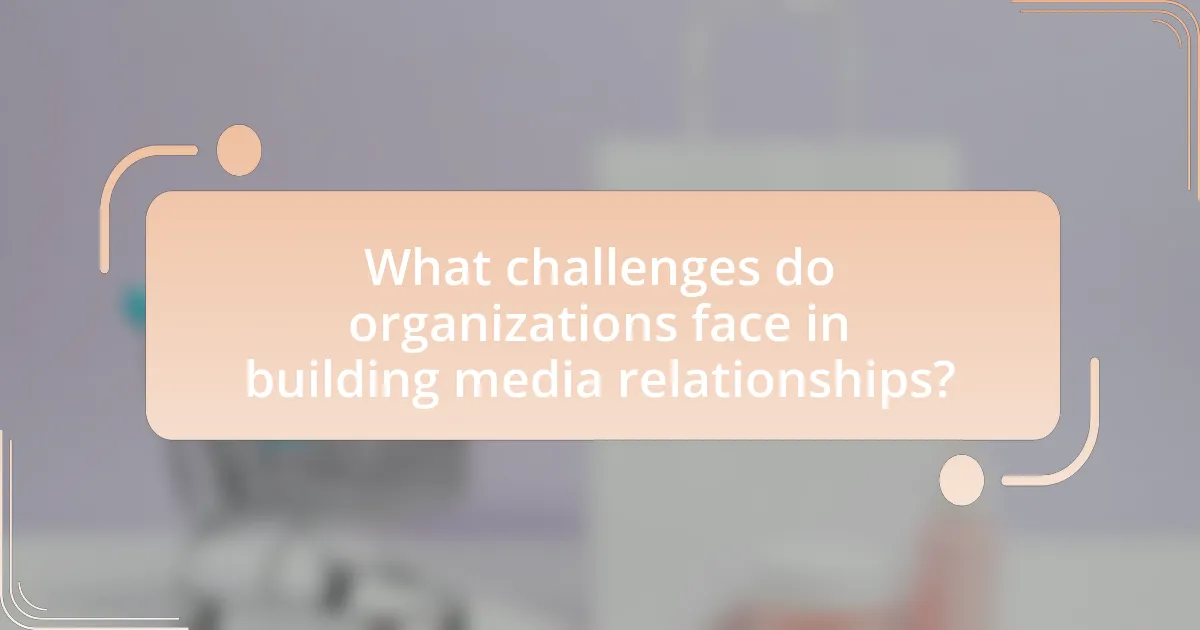Building effective media relationships in a digital age involves creating strong connections with journalists and media outlets through digital platforms, ensuring accurate and favorable coverage. The article explores how the digital landscape has transformed these relationships, emphasizing the importance of transparency, rapid communication, and authenticity. It discusses strategies for identifying the right media contacts, leveraging media databases, and employing effective communication techniques to enhance engagement. Additionally, the article addresses challenges organizations face in building media relationships and offers best practices for maintaining these connections over time, ultimately highlighting the significance of media relationships in shaping brand reputation and communication strategies.

What does it mean to build effective media relationships in a digital age?
Building effective media relationships in a digital age means establishing and maintaining strong connections with journalists and media outlets through digital platforms to ensure accurate and favorable coverage. This involves utilizing social media, email, and online press releases to communicate effectively, share relevant information, and engage with media professionals. Research indicates that 70% of journalists prefer to receive pitches via email, highlighting the importance of digital communication in fostering these relationships. Additionally, understanding the preferences and needs of media personnel can lead to more successful collaborations, as evidenced by studies showing that personalized outreach increases response rates by up to 50%.
How has the digital landscape changed media relationships?
The digital landscape has transformed media relationships by enabling direct communication between content creators and audiences, bypassing traditional gatekeepers. This shift allows for real-time engagement, fostering a more interactive and responsive relationship between media entities and their consumers. For instance, social media platforms have become essential tools for journalists and brands to connect with their audiences, leading to increased transparency and immediacy in information dissemination. According to a 2021 Pew Research Center study, 53% of U.S. adults reported getting news from social media, highlighting the significant role digital platforms play in shaping media consumption and relationships.
What are the key characteristics of media relationships today?
The key characteristics of media relationships today include increased transparency, rapid communication, and a focus on authenticity. Increased transparency is essential as media outlets and audiences demand honesty and openness from organizations, fostering trust. Rapid communication is facilitated by digital platforms, allowing for immediate interaction and feedback between media professionals and their audiences. Additionally, a focus on authenticity is crucial, as audiences prefer genuine narratives over polished marketing messages, leading to stronger connections. These characteristics reflect the evolving landscape of media relationships, driven by technological advancements and changing audience expectations.
How do digital platforms influence media interactions?
Digital platforms significantly influence media interactions by facilitating real-time communication and content sharing among users and media organizations. These platforms enable immediate feedback and engagement, allowing audiences to interact directly with media content through comments, shares, and likes. For instance, a study by the Pew Research Center found that 62% of adults in the U.S. get news from social media, highlighting how these platforms shape news consumption and audience engagement. Additionally, algorithms on platforms like Facebook and Twitter prioritize content based on user preferences, further influencing which media interactions are most visible and engaging.
Why are effective media relationships important for organizations?
Effective media relationships are crucial for organizations because they enhance visibility and credibility. When organizations maintain strong connections with media outlets, they can ensure that their messages reach a broader audience, which is essential in a competitive landscape. Research indicates that 70% of consumers trust news articles more than advertisements, highlighting the importance of media coverage in shaping public perception. Furthermore, effective media relationships can lead to timely and favorable coverage, which can significantly impact an organization’s reputation and stakeholder engagement.
What role do media relationships play in brand reputation?
Media relationships significantly influence brand reputation by shaping public perception and facilitating communication between brands and their audiences. Strong media relationships enable brands to secure positive coverage, which enhances credibility and trust among consumers. For instance, a study by the Pew Research Center found that 67% of consumers trust news articles more than advertisements, highlighting the importance of media in shaping brand narratives. Additionally, effective media engagement can lead to increased visibility and awareness, further solidifying a brand’s reputation in the marketplace.
How can media relationships enhance communication strategies?
Media relationships enhance communication strategies by facilitating the dissemination of information to a broader audience through trusted channels. Establishing strong connections with journalists and media outlets allows organizations to gain credibility, as media coverage can validate their messages and initiatives. For instance, a study by the Pew Research Center indicates that 67% of people trust news organizations, which underscores the importance of media in shaping public perception. By leveraging these relationships, organizations can ensure their narratives are accurately represented, leading to improved engagement and a more effective communication strategy.

What strategies can be employed to build effective media relationships?
To build effective media relationships, organizations should prioritize transparency, consistent communication, and personalized engagement. Transparency fosters trust, as media professionals appreciate honesty about organizational goals and challenges. Consistent communication ensures that media contacts are regularly updated with relevant information, making them more likely to cover the organization positively. Personalized engagement, such as tailoring pitches to specific journalists’ interests, increases the likelihood of media coverage. Research indicates that 70% of journalists prefer receiving personalized pitches, highlighting the importance of understanding their preferences and needs.
How can organizations identify the right media contacts?
Organizations can identify the right media contacts by researching journalists and media outlets that align with their industry and target audience. This involves analyzing the coverage of specific topics relevant to the organization, utilizing media databases, and leveraging social media platforms to find journalists who have previously reported on similar subjects. For instance, a study by Cision in 2021 indicated that 70% of journalists prefer to receive pitches that are tailored to their specific beat, highlighting the importance of targeted outreach. By focusing on journalists who have demonstrated interest in related topics, organizations can enhance their chances of successful media engagement.
What criteria should be used to evaluate media relevance?
To evaluate media relevance, criteria such as audience alignment, content quality, timeliness, and platform suitability should be used. Audience alignment ensures that the media reaches the intended demographic, which is crucial for effective communication. Content quality assesses the accuracy, depth, and engagement level of the information presented, as high-quality content fosters trust and credibility. Timeliness evaluates whether the media is current and relevant to ongoing discussions or events, which can significantly impact its effectiveness. Lastly, platform suitability considers whether the media is appropriate for the specific channels being used, as different platforms cater to different audiences and content types. These criteria collectively ensure that media efforts are strategically aligned with communication goals and audience needs.
How can organizations leverage media databases effectively?
Organizations can leverage media databases effectively by utilizing them for targeted outreach, relationship management, and content distribution. By accessing comprehensive contact information and media profiles, organizations can identify and connect with journalists and influencers who align with their industry and messaging. This targeted approach increases the likelihood of media coverage and enhances the quality of relationships built over time. For instance, a study by Cision found that 70% of journalists prefer personalized pitches, highlighting the importance of tailored communication facilitated by media databases. Additionally, organizations can track engagement metrics and media mentions through these databases, allowing for data-driven adjustments to their media strategies.
What communication techniques foster strong media relationships?
Effective communication techniques that foster strong media relationships include transparency, timely responses, and personalized interactions. Transparency builds trust, as media professionals appreciate honesty about information and intentions. Timely responses demonstrate respect for journalists’ deadlines and enhance credibility, as studies show that quick replies can lead to more favorable coverage. Personalized interactions, such as addressing journalists by name and tailoring pitches to their specific interests, create a sense of connection and increase the likelihood of engagement. These techniques are supported by research indicating that strong media relationships are built on mutual respect and understanding, which are cultivated through effective communication practices.
How can storytelling enhance media engagement?
Storytelling enhances media engagement by creating emotional connections that resonate with audiences. When narratives are woven into media content, they capture attention and foster relatability, leading to increased viewer retention and interaction. Research indicates that stories are processed in the brain differently than facts alone; for instance, a study by Paul Zak found that storytelling can increase oxytocin levels, which promotes empathy and connection. This emotional engagement translates to higher levels of sharing and discussion, ultimately amplifying the reach and impact of media messages.
What are best practices for pitching to journalists?
The best practices for pitching to journalists include crafting a compelling subject line, personalizing the pitch, and providing relevant information succinctly. A compelling subject line captures attention and increases the likelihood of the email being opened; studies show that 47% of email recipients decide whether to open an email based solely on the subject line. Personalization demonstrates that the sender has researched the journalist’s work, which can enhance the relationship and increase the chances of a response. Additionally, providing relevant information succinctly respects the journalist’s time and aligns with the fast-paced nature of news reporting, as journalists often receive numerous pitches daily.

What challenges do organizations face in building media relationships?
Organizations face several challenges in building media relationships, including a lack of understanding of media dynamics, difficulty in establishing trust, and the rapid evolution of digital communication platforms. The complexity of media landscapes often leads to miscommunication, as organizations may not fully grasp how journalists operate or what they need for effective storytelling. Trust issues arise when organizations fail to provide timely and accurate information, which can damage credibility. Additionally, the fast-paced nature of digital media requires organizations to adapt quickly to new technologies and trends, making it challenging to maintain consistent and meaningful engagement with media professionals. These challenges are compounded by the increasing competition for media attention, which can further strain relationships.
How can organizations overcome common obstacles in media relations?
Organizations can overcome common obstacles in media relations by establishing clear communication strategies and fostering strong relationships with journalists. Effective communication strategies include creating tailored press materials that address the specific interests of media outlets, ensuring timely responses to inquiries, and maintaining transparency about organizational activities. Building strong relationships involves regular engagement with journalists through networking events, personalized outreach, and providing exclusive content that adds value to their reporting. Research indicates that organizations that prioritize relationship-building see a 30% increase in positive media coverage, demonstrating the effectiveness of these approaches in enhancing media relations.
What strategies can mitigate negative media coverage?
To mitigate negative media coverage, organizations should proactively engage with media outlets, establish transparent communication, and respond promptly to misinformation. Proactive engagement involves building relationships with journalists and providing them with accurate information, which can help shape the narrative before negative stories arise. Transparent communication ensures that stakeholders are informed about organizational actions and decisions, reducing speculation and misunderstandings. Additionally, responding promptly to misinformation allows organizations to correct inaccuracies quickly, minimizing potential damage to their reputation. Research indicates that organizations that maintain open lines of communication with the media experience fewer instances of negative coverage, as they are better equipped to manage their public image effectively.
How can organizations handle media crises effectively?
Organizations can handle media crises effectively by implementing a proactive communication strategy that includes timely and transparent information dissemination. This approach ensures that stakeholders receive accurate updates, which helps to mitigate misinformation and maintain trust. For instance, during the 2017 United Airlines incident, the company faced significant backlash due to poor communication; however, organizations that prioritize clear messaging and engage with media promptly can prevent escalation and manage public perception more effectively.
What tools and technologies can support media relationship building?
Media relationship building can be supported by tools and technologies such as media databases, social media platforms, and communication software. Media databases like Cision and Meltwater provide access to journalist contacts and media outlets, facilitating targeted outreach. Social media platforms, including Twitter and LinkedIn, enable real-time engagement and relationship nurturing with journalists and influencers. Communication software, such as Slack or Microsoft Teams, allows for streamlined collaboration and information sharing among PR teams, enhancing the effectiveness of media strategies. These tools collectively enhance the ability to connect, engage, and maintain relationships with media professionals.
How can social media be utilized to strengthen media connections?
Social media can be utilized to strengthen media connections by facilitating direct communication and engagement between media professionals and their audiences. Platforms like Twitter and LinkedIn allow journalists and media outlets to share content, receive immediate feedback, and build relationships with their followers and sources. For instance, a study by the Pew Research Center found that 62% of journalists use social media to connect with sources, demonstrating its effectiveness in fostering professional relationships. Additionally, social media enables media organizations to promote their work, collaborate on projects, and participate in discussions, further enhancing their visibility and credibility within the industry.
What role do media monitoring tools play in relationship management?
Media monitoring tools play a crucial role in relationship management by enabling organizations to track and analyze media coverage and public sentiment. These tools provide real-time insights into how a brand or individual is perceived in the media, allowing for timely responses to both positive and negative coverage. For instance, a study by Cision found that 70% of PR professionals use media monitoring to inform their communication strategies, demonstrating its importance in shaping effective media relationships. By leveraging data from these tools, organizations can tailor their messaging, engage with stakeholders more effectively, and ultimately enhance their reputation in the digital landscape.
What are the best practices for maintaining media relationships over time?
The best practices for maintaining media relationships over time include consistent communication, providing valuable content, and respecting journalists’ deadlines. Consistent communication fosters trust and keeps the relationship active, while providing valuable content ensures that journalists see you as a reliable source. Respecting deadlines is crucial, as it demonstrates professionalism and reliability, which are essential for long-term partnerships. According to a study by the Public Relations Society of America, 70% of journalists prefer to receive regular updates from PR professionals, highlighting the importance of ongoing engagement in maintaining these relationships.
How often should organizations engage with media contacts?
Organizations should engage with media contacts regularly, ideally on a monthly basis. This frequency allows organizations to maintain visibility and relevance in the media landscape, ensuring that their messages are consistently communicated. Research indicates that consistent engagement helps build trust and rapport with journalists, which can lead to more favorable coverage and stronger media relationships. For instance, a study by the Public Relations Society of America found that organizations that maintain regular contact with media professionals are more likely to be included in news stories, highlighting the importance of ongoing communication.
What follow-up strategies can ensure lasting media relationships?
Consistent and personalized communication is essential for ensuring lasting media relationships. Following up with journalists and media contacts after initial outreach or coverage fosters trust and demonstrates commitment. Regularly sharing relevant updates, exclusive content, or insights tailored to their interests keeps the relationship active. Research indicates that 70% of journalists appreciate personalized pitches, which highlights the importance of understanding their preferences and needs. Additionally, acknowledging their work and providing constructive feedback can strengthen the bond, as it shows respect for their expertise and contributions.